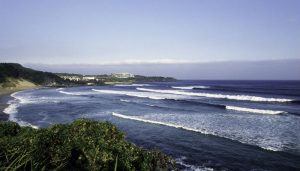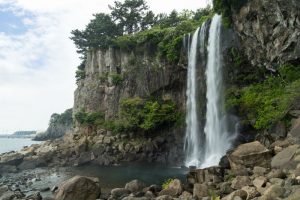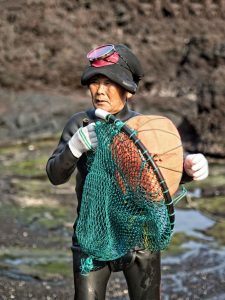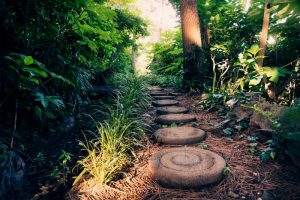The most popular honeymoon travel destination in South Korea, the Province of Jeju is located in the Korea Strait. It is known for its tropical golden sand beaches, inactive volcanoes, quirky museums and theme parks. Also known as the ‘Korean Hawaii’- Jeju Island will live up to its name with the beautiful beaches, lush countryside and seaside hotels designed for rest and relaxation.
By the way, if by any chance you’re into Kdramas, let me just grab your attention with – BOYS OVER FLOWERS! Yes, it was shot here!

Fill up your travel itinerary with the places listed below and enjoy the idyllic scenery, balmy temperatures that will give a feeling that you’re in a Korean drama film or TV show (and honestly, who doesn’t want that?)
Also Read: 11 Islands You Have To Visit This Summer
Cheonjiyeon Falls
The word “Cheonjiyeon” means ‘sky connected with land’ and that’s what you see when your eyes take in the 22 m high and 12 m wide waterfall. Consisting of three different waterfalls and each is unique in its own way.

Extremely photogenic and refreshing cascade will sweep you into bliss with its spectacular scenery and rejuvenating ice-cold waters.
Jungmun Beach
With the breathtaking sceneries that Jeju offers, one simply cannot miss the Jungmun Beach! This beautiful 560m long beach provides tourists with a clear beautiful view of the sea.

The beach is by far has the fiercest waves and therefore provides a favourite spot for Korea’s surfing enthusiasts, where once a year, they meet at this spot to take part in the Jeju International Surfing Competition.
Jeonbang Falls
Check out the only waterfall in Asia that falls directly into the sea!

This waterfall is 23 m high and depending on the level of recent rainfall, can be up 8 m wide. Sit on the rocky beach and watch as the waves roll in. There is an inscription on the wall of the waterfall which says –“Seobulgwacha”, which refers to the journey of a servant of the Chinese Emperor Jin –Seobul.
Mount Hallasan
The highest point in Korea, Hallasan Mountain rises to 1,950 meters (6,398 feet) above the sea-level. Plan a hike to the majestic Hallasan mountain and you will get to see its vast crater lake as well as a myriad of intriguing creatures.

So, climb this dormant volcano that is listed as a UNESCO World Natural Heritage sites for scenic views of Jeju from above! Surrounding the mountain is the Hallasan National Park which is also home to over 4,000 animal species throughout its vertical ecosystem.
Seongeup Folk Village and Jeju Folk Village
So, there are two Folk villages in Jeju Island– Seongeup Folk Village and Jeju folk village. And of course one must understand the difference between them. While both of them are tourist attractions at Jeju, Seongeup Folk Village is a well-preserved village which is very real; and, Jeju Folk Village is a museum which takes you down the memory lane and lets you have a taste of the 19th century way of life in Korea.

Seongeup Folk village has been preserved with government assistance; and there are still people living there the way their ancestors did. There are traditional rock-walled, thatched-roofed houses where often the locals will invite you to try a hand at some of their daily chores done the old Korean traditional way.
Sunrise Peak (Seongsan Ilchulbong)
This 182-meter-high cone is another UNESCO World Heritage Site from Jeju. Rising from the sea with a wide, green crater on the island’s eastern edge, Seongsan Ilchulbong will give you a sight to behold during the sunrise. It’s okay, sacrifice your sleep for one morning because it will be WORTH IT!

As the beach is mostly made of black lava rock, you will be in awe as countless pools of still water will reflect the glow of the sun while it rises above the 5,000-year-old volcanic crater.
So while you are already here, take a detour on the way down and go watch women divers (called haenyo) at the black sand beach. These women with an average age of 65 dive 10-20 meters without any breathing apparatus and catch fresh seafood! No kidding!

Manjanggul Cave
Manjanggul Cave is another UNESCO World Heritage site in Jeju and is formed by cooling lava. The cave is more than eight kilometres long and flaunts a mix of eye-catching natural formations. These include long stalagmites and lava tube tunnels which, thanks to the soft-coloured illuminating lights, look both magical and spooky.

Olle Trails
One can appreciate rural Jeju with these 20 something walking trails that stretch around the entire coast of the island. In Jeju’s traditional dialect, Olle means a narrow path between the street and one’s doorstep.

The trails allow you to connect with the people and the island through various landscapes along the way; including small villages, beaches, farms and forests. Each route is also marked by arrows, sculpture or coloured tags and assuringly leads you to picturesque mountain scenery, neighbourhood backyards and breathtaking beachfront shores.
Also Read: 13 Delectable Korean Dishes to Try in South Korea
With experiences that you simply must not miss, plan your next romantic getaway or even just a weekend getaway for yourself to Jeju and do let us know how it went!


